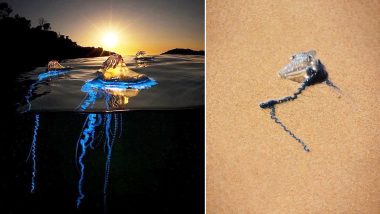Mumbai, July 30: It may seem like a good idea to take a stroll on the beach shore in the rainy season, but along with the waves, there are poisonous visitors on the beaches of Girgaum and Juhu in Mumbai. Called the 'Blue Bottle' jellyfish these are poisonous species and can cause hurt and pain to humans with their touch. Experts have thus advised the citizens to not roam around the beach shores barefoot.
A team of experts from 'Marine Life of Mumbai' have come across the poisonous species near the two very popular beach spots in the city. The species may look attractive with its umbrella-like shape but some of their variety can seriously hurt and cause damage, with its sting. There have been instances in the past, where people who went for Ganpati immersion in the seas, have been stung by these jellyfish. The Mumbai seashores see three types of jellyfish from season to season. The 'Blue Button jellyfish' is seen before the monsoon, the 'Blue bottle jellyfish' during the monsoon season and the 'Box jellyfish' after the rains recede. These jellyfish reach the seacoasts due to the strong winds that blow during the monsoon. They are light in weight which is why they get easily drifted out with the waves.
What is the Blue Bottle Jellyfish?
The 'Blue Bottle' jellyfish is also called the 'Portuguese Man of War,' and it gets the name from its resemblance to an 18th century armed sailing ship. The sting from its tentacles can give a very painful sting, which can prove deadly to humans as well as other marine life. They grow from 9 to 30 cms and extend up to 15 cm above the water. Their shape makes them very attractive and one would want to touch them, but it is a very bad idea, as it can prove deadly in extreme cases. Their sting causes a red rash and the pain can be unbearable lasting for up to 3 hours if severe. They are very commonly found in the Indian and Pacific Oceans. The species is also responsible for up to 10,000 human stings in Australia each summer. T
The sting of a 'Blue bottle jellyfish' look like whip marks. The treatment of one would involve applying salt water to rinse away the microscopic organisms. Also, try and put warm water. The heat in the water tries to break down the toxins that are present on the skin through their venom. To reduce the effects of the pain, apply alcohol or spirit over the wound.
(The above story first appeared on LatestLY on Jul 30, 2018 05:39 PM IST. For more news and updates on politics, world, sports, entertainment and lifestyle, log on to our website latestly.com).













 Quickly
Quickly


